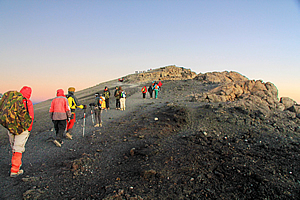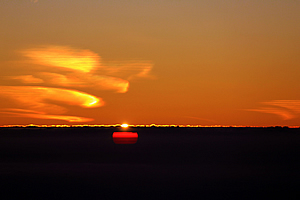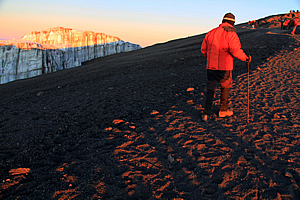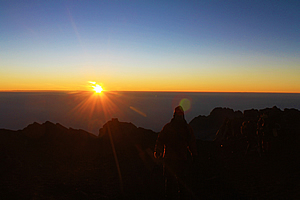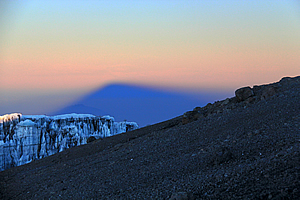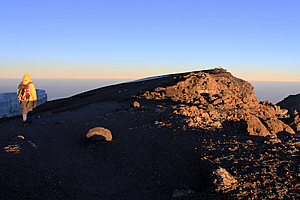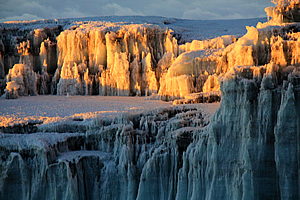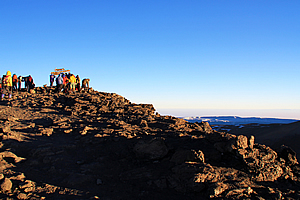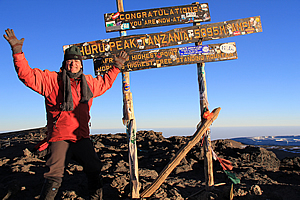--- Archive files ---
Home > Treks > Kilimanjaro > Day 6 > 6.5 |
Achievement
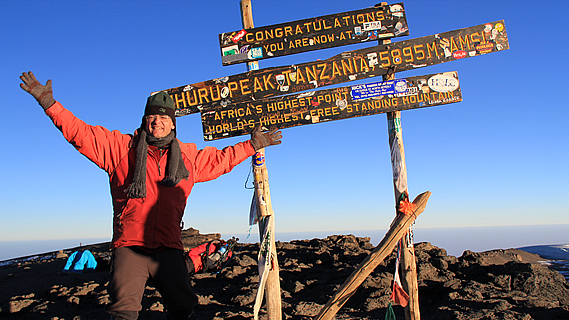
I WAS very close to the summit of Mount Kilimanjaro. The entire sky was a deep blue by now, so I turned off my head lamp. Ahead of me was a steep section of rubble leading to the summit. From here it was just one hundred and sixty five metres of climbing to go.
Final climb to the summit |
I inched my way up quite painfully, leaning on my pole as an old person would use a walking frame. It would have seemed ridiculous, but everyone else on the mountain was doing the same, struggling their way along very slowly.
I began to feel disoriented as a headache began to form. I crossed my fingers hoping it wouldn’t get too severe. Just a hundred and fifty metres short of the summit and I was finally just beginning to experience symptoms of altitude sickness.
The sun rises over clouds 1500km away |
The symptoms were not severe though, so I continued towards the summit. It was just ahead of me now. Vicky was just a few metres ahead of me. Above the summit the moon stood very bright leading the way. To the right the barren crater loomed with the far side of the crater clearly visible on the other side, and more glaciers sitting on top of the distant ridge.
A few metres behind me was Jaseri who was walking with Gary and Dawn.
Struggling the final steps to the summit |
Then at 6:27, six and a half hours after leaving Kibo, the sun suddenly rose over the distant horizon. It rose through the haze, then through a very thin band of mid-level cloud, highlighting some high cloud further beyond, perhaps fifteen hundred kilometres away over the Indian Ocean.
Within seconds the sun was shining, highlighting on the tops of the glaciers, and illuminating their bright white and deep blue tones making them look like icebergs sitting on the barren volcanic regolith. This was especially so on the Furtwanger Glacier on top of a small plateau across the other side of the crater a good kilometre away.
Sunrise |
I could now see clearly into the huge crater. Although it had not erupted for over three hundred and sixty thousand years, there were fumaroles active in the crater. Scientists believe there is molten rock just four hundred metres below the crater's surface. Activity has been measured just two hundred years ago, raising the status of the mountain to a dormant volcano. With magma so close to the surface who knows how soon it will be before it erupts again.
A minute later at 6:33 the sun was already well above the distant clouds. Looking in the other direction as I walked I could clearly see the shadow of the mountain extending out some six hundred kilometres to the west, creating an amazing indigo shadow, even more impressive than the one I had seen from the top of Mount Kinabalu in Borneo last year.
Shadow of the mountain |
From there I could see the summit, and the obvious wooden sign erected at the top. There were already about twenty climbers up there – it really was a bit of a crowd for such a hostile and barren place so far away from anywhere!
I continued climbing, passing another glacier that was clean cut along the side. I could see layers in the face, indicating different climates over the years when the glacier. The white layers indicated times of plentiful snowfall, and the brown layers indicating periods of melt and dust storms.
Final approach to the summit |
Kilimanjaro was first attempted in 1861, but the climbers got no further than two thousand five hundred metres. One of the climbers had another attempt the following year reaching about four thousand three hundred metres, the level of the plateau between Kibo and Mawenzi.
In 1887 Sebastiaan Meyer made his first attempt at the summit, but turned back at the base of Kibo not having the equipment to handle the steep snow and ice that covered the peak at the time. He made another attempt with two others the following year, but before they even reached the base of the mountain they were captured and held hostage until a ten thousand rupee ransom was paid.
Glacier with some fresh snow on it |
In 1889 Meyer returned to Kilimanjaro with the Austrian Ludwig Pruscheller for a third attempt. They finally reached the summit on Purscheller’s fortieth birthday on 8 October 1889. From the summit they went down to climb Mawenzi Peak, spending a total of sixteen days above four thousand metres.
It was 6:49 AM, twenty two minutes after sunrise, and nearly seven hours after leaving Kibo, that I reached the summit. The summit was plain Martian rock boulders exposed from the cover of glaciers. It had only been the last couple of decades that the top has been free of glacial ice.
A small crowd at the summit |
A large wooden signpost stood there covered in little advertising stickers saying; “Congratulations, you are now at Uhuru Peak, Tanzania, 5895 M AMSL. Africa’s Highest Point, World’s highest free standing mountain”.
I had done it.
Uhuru is the Swahili name for freedom. There is a telling around mountaineering circles around the world that from here at the top of Kilimanjaro you can see more land than from anywhere else on the planet. Although there are higher mountains, none of them have such uninhibited views of the landscape around the summit. Here I was nearly as high as a jetliner – actually at the cruising altitude of a turboprop plane, but with uninhibited views without any portholes to look through. This truly was the place of freedom.
Standing on the summit |
I gave my camera to Imara and he took several pictures of me as I briefly celebrated turning forty. There were a few small flags flapping around in what was now the gentlest of breeze.
Behind me were a couple of people lying on the ground. I didn’t think that was a great idea though. There were even more people on the ground in front of me.
Once my photo was taken, I moved away and sat down as I was suddenly feeling quite dizzy - the first signs of altitude sickness. Vicky and a couple of others got their photo taken as Dawn asked if I could get a photo of them. Their camera had died at Gilman’s Point. I was happy to oblige and fortunately managed to stand up to get a picture of them with Jaseri as he had been their guide up the last part of the mountain. I felt if I had remained sitting, I may have passed out into unconsciousness. Obviously climbing two thousand one hundred metres in one twenty four hour period – seven times the maximum my doctor recommended, was starting to take its toll.
<< Previous | Next >> |
|
||
About this Page
|
||
|
|
|
Where is Walkabout Jeff? |
|
|
|
|
What is happening in Walkabout Jeff's hometown?
|
|
|
|
|
Who is Walkabout Jeff?Any normal person's idea of going out involves going to the local pub for a drink with a few mates. Walkabout Jeff isn't normal.
|
|
|
|
|
